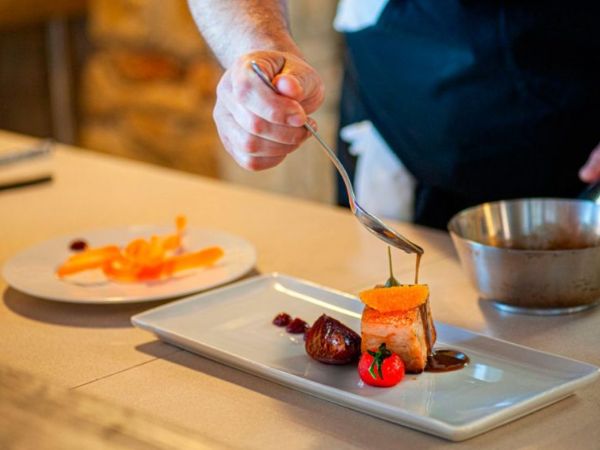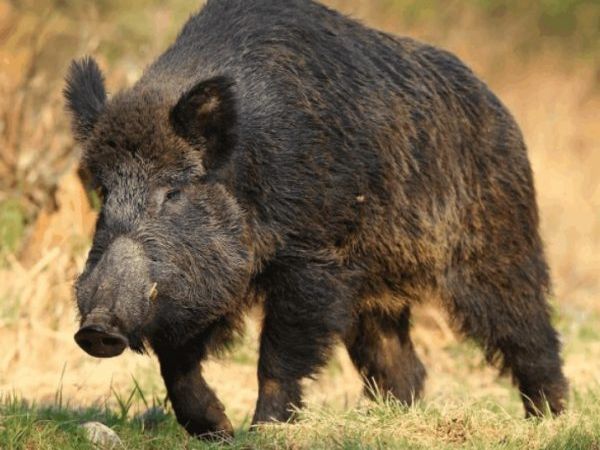When thinking about wild boars, one immediately envisions an animal that embodies the essence of hunting. Since ancient times, this suid has been a prominent figure in mythology, art, and hunting culture across the Old Continent.
From Meleager, who hunted the Calydonian boar, to Hercules and his twelve labors, the wild boar has always symbolized strength, valor, and courage. Its figure, depicted in Roman mosaics, Etruscan frescoes, and Renaissance paintings, tells the story of an iconic, proud, and combative animal that has been considered the ultimate game animal for centuries. But what is the history of wild boars in Italy? How has their presence evolved amidst adaptations, hybridizations, and management challenges?

Beyond its hunting significance, the wild boar is also a top-tier culinary resource. Its meat, prized for its robust flavor and versatility in the kitchen, plays a central role in regional Italian cuisine, making the hunting of this animal not only a sporting and cultural activity but also a source of high-quality food.
The Italian Wild Boar: Varieties and Transformations
Over time, the Italian peninsula has been home to various types of wild boars, including the famous Maremman wild boar (Sus scrofa majori), a subspecies distinguished by its smaller size, an adaptation to arid and less productive environments. First described in 1927 by De Beaux and Festa, this variety is considered native to central and southern Italy, particularly the Maremma region and the Metalliferous Hills of Tuscany. However, its genetic purity has been compromised over time, especially since the 1960s, with the introduction of wild boars from Eastern Europe (Sus scrofa scrofa) and, according to some sources, even hybridized with domestic pigs.
These restocking practices, though criticized today, were once common, aimed at reinforcing depleted or declining game populations. The effects of these introductions have sparked debates about the genetic value of Sus scrofa majori, with differing opinions on whether it should be considered a distinct species or merely an ecotypic variation of the European wild boar. Recent studies, however, suggest that while hybridization has occurred, it has not entirely erased the genetic uniqueness of the Maremman wild boar.
Wild Boar Hunting: A Symbol and a Challenge for Hunters
Hunting wild boars is a unique experience, deeply rooted in history and tradition, and also a true challenge for hunters. Why? First and foremost, the wild boar is an exceptionally adaptable animal capable of thriving in diverse environments, from oak forests to agricultural areas. Its intelligence, coupled with complex social behavior, makes every encounter an exciting adventure.

It is not just the challenge of hunting that makes the wild boar special: it has always been a symbol of strength and resilience. Its robustness and survival instincts make it a game animal that demands respect and skill. In particular, selective hunting techniques allow hunters to ethically engage with the animal while preserving its ecological value and regulating populations.
Wild Boar Meat: A Premium Resource
One of the most appreciated aspects of the wild boar is its meat, renowned for its intense, gamey flavor and versatility in cooking. Its firm texture and distinctive aroma make it ideal for hearty dishes that highlight culinary tradition.
Nutritional Characteristics
Nutritionally, wild boar meat is lean, high in protein, and lower in fat compared to other red meats. It is an excellent choice for those seeking a healthy and natural product, especially considering that wild boars feed primarily on what nature provides, such as acorns, roots, and wild fruits.
Regional Recipes
Each Italian region has developed recipes that enhance the unique taste of wild boar meat:
In Tuscany, wild boar alla cacciatora is a signature dish, prepared with red wine, juniper berries, garlic, and tomato.
In Umbria, wild boar is often featured in cured meats like sausages or prosciutto, valued for their bold flavor.
In Sardinia, it is stewed with myrtle, a signature herb of the island.

In Abruzzo and Molise, wild boar ragù is a rich and flavorful sauce, perfect for homemade pasta like pappardelle.
In Emilia-Romagna, it is used in stews, often paired with steaming polenta.
These dishes, combining tradition and taste, showcase the culinary versatility of wild boar meat and its deep-rooted role in Italian gastronomy.
The Evolution of Wild Boars in Italy
In recent decades, wild boar populations in Italy have expanded significantly, aided by environmental transformations and changes in land management. After a historical low in the 1920s, Italy’s forested area has increased by over 1.8 million hectares, with a 36% rise in broadleaf forests such as oaks, chestnuts, and beeches, which provide an abundant food source for wild boars. This increase in food availability has led to higher fertility rates and larger average sizes among wild boars, phenomena closely tied to improved environmental conditions.
However, recolonization has not been uniform. While central and southern Italy have seen the survival of local ecotypes like the Maremman wild boar, alpine and Po Valley areas have been repopulated by European-origin boars, often larger and more prolific. In some regions, hunting pressure and climate change have further influenced the morphological and behavioral characteristics of wild boars.
A Magnificent Game Animal That Demands Careful Management
Managing wild boars requires a delicate balance between conservation and population control. On one hand, hunting is a vital tool for regulating their numbers and preventing damage to agriculture and ecosystems. On the other, it is crucial to adopt a scientific approach that accounts for the genetic characteristics and ecological dynamics of this species.
Hunting wild boars, in its various forms (driven hunts, stalking, or selective shooting), is one of the most rewarding hunting experiences, not only for the challenge it represents but also for the deep connection it fosters with the land. Moreover, the culinary value of its meat underscores the importance of promoting a complete and sustainable use of this game animal.

The wild boar is not just a fascinating game animal but also a central figure in cultural, hunting, and gastronomic traditions. Its presence, as a symbol of strength and a management challenge, offers an opportunity to reconnect with nature and the traditions of the past. Preserving the Maremman wild boar and carefully managing hybrid populations is a responsibility that falls not only on hunters but on the entire scientific and managerial community.
The wild boar is, therefore, a magnificent game animal, valued not only by hunters seeking to test their skills but also by culinary enthusiasts who find in its meat a unique flavor capable of telling the story and taste of our land.
FAQs – Wild Boar Hunting in Italy
1. What are the best regions in Italy for wild boar hunting?
Italy offers diverse landscapes for wild boar hunts, with some of the most rewarding areas located in Tuscany, Lazio, Abruzzo, Sardinia, and Calabria. Each region brings its own terrain flavor, from the vineyard-draped hills of Chianti to the dense forests of Abruzzo, the rugged Sardinian highlands to the wild chestnut woods of southern Calabria.
2. What are the main hunting methods used for boar in Italy?
There are three popular hunting styles:
- Battuta (Driven Hunt): Dogs and beaters flush boars toward static hunters—an adrenaline-filled tradition especially common in Tuscany and Lazio.
- Stalking (Caccia di Selezione): A silent and solitary pursuit, ideal for experienced hunters at dawn or dusk.
- High-Seat Hunting: Stationary observation from blinds or towers near feeding paths or watering spots.
3. When is the wild boar hunting season in Italy?
Boar hunting usually spans from early October to late January, but regional regulations may shift this window slightly. In Abruzzo, for instance, autumn is preferred, while Sardinia and Calabria may allow hunting later into winter.
4. What type of terrain should I expect during a hunt?
You’ll navigate varied environments: oak and chestnut groves, scrub-covered slopes, steep woodland trails, and rocky clearings. Each region offers its unique physical challenge, Chianti’s rolling landscapes, Sardinia’s karst plateaus, or Calabria’s dense brush.
5. What gear should I bring for wild boar hunting in Italy?
Robust 12-gauge shotgun (side-by-side or over-under) or a medium-caliber rifle is recommended. Don’t forget waterproof boots, hi-vis clothing, quality optics, and weather-appropriate outdoor wear. Montefeltro will guide you on gear compliance and logistics.
6. Are wild boars a problem in Italy?
Yes, wild boars are expanding rapidly. They damage crops, disturb ecosystems, and cause car accidents, especially in regions like Lazio and Tuscany. Controlled hunting plays a vital role in wildlife balance.
7. Why is population control of wild boar so important?
Beyond damaging agriculture, boars contribute to the spread of African Swine Fever and create ecological imbalance. Hunting is essential to maintain a healthy equilibrium in Italy’s rural zones.
8. What licenses do international hunters need to join a boar hunt in Italy?
Non-resident hunters must obtain an Italian hunting license, a regional permit, and insurance. Montefeltro manages the entire process on your behalf to ensure legal compliance before your arrival.
9. What kind of lodging is included during the hunt?
Expect charming accommodations, from elegant hunting estates to cozy countryside villas. Many offer local cuisine, wine tastings, and traditional Tuscan hospitality close to the hunting grounds.
10. Are wild boars aggressive?
They can be. Male boars, especially during the rutting season (November–January), may charge if threatened. Professional guides ensure safety with structured protocols and emergency preparedness.
11. How many boars can I expect to harvest during a trip?
It depends on hunting method and region. In driven hunts, skilled participants might harvest two or more boars per day, depending on group coordination and terrain.
12. Is wild boar hunting in Italy suitable for beginners?
Absolutely. we offers packages tailored to first-timers, especially via guided hunts. For seasoned hunters, stalking offers a rewarding and challenging experience.
13. Is the hunting experience sustainable and ethical?
Yes, Montefeltro prioritizes conservation: strict quotas, seasonal planning, ethical tracking, and environmental stewardship ensure a responsible experience that respects wildlife.
14. Can I combine hunting with sightseeing?
Definitely. Enjoy visits to Renaissance villages, vineyards, olive groves, and Sardinian coasts, or explore culinary tours and truffle hunts as part of your hunting trip.
15. What makes hunting wild boar in Tuscany so iconic?
It’s a living tradition: from the early morning horn calls echoing through vineyards to post-hunt feasts with wine, cheese, and local stories. Tuscany blends sport with culture like nowhere else.
16. Are dogs used in every type of hunt?
Only in driven hunts. Well-trained dogs are critical for flushing game toward shooters. In stalking hunts, dogs are avoided to maintain silence and stealth.
17. Do hunting regulations vary across Italian regions?
Yes. Italy’s regions manage wildlife independently. Dates, species limits, and firearm rules may differ. Montefeltro ensures compliance with the latest updates for each destination.
18. Is hunting in Italy logistically easy for foreigners?
Yes. Italy boasts a well-connected transport network and Montefeltro provides support with firearm import, airport pick-up, and local translation. English-speaking staff ensure a smooth journey.
19. What happens to the meat and trophies?
Harvested boars are processed respectfully. Meat can be prepared locally or packaged. Tusks and hides may be preserved for taxidermy or souvenirs, upon request.
20. Why hunt with Montefeltro?
Because with Montefeltro, hunting becomes an emotional journey. You won’t just pull the trigger—you’ll breathe in ancient woodlands, share laughter with locals, and take home stories that live longer than any trophy.







